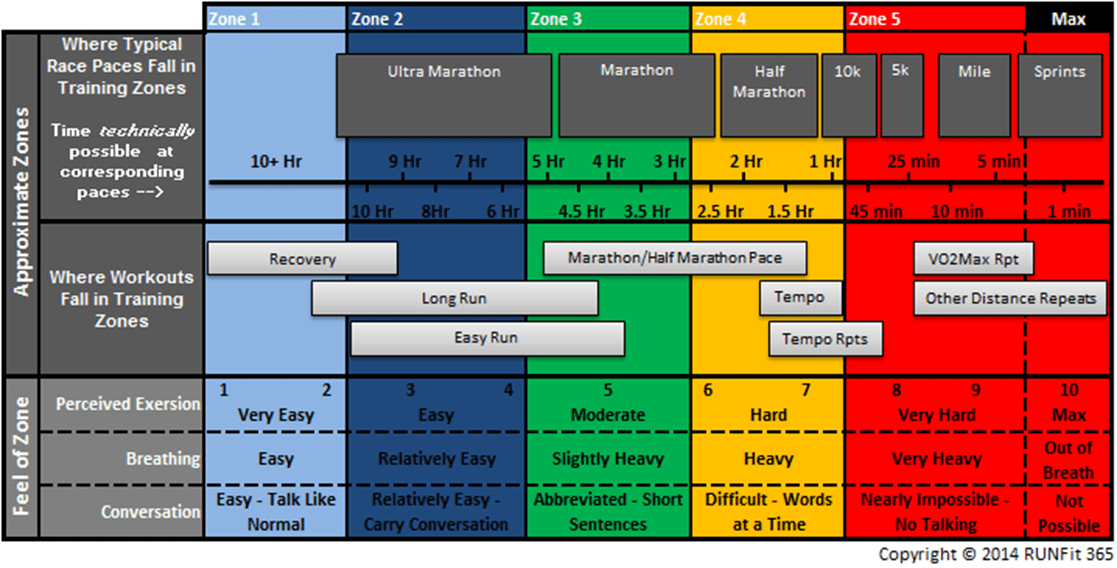The Long Run - Benefits and Tips for Your Long Run
Running, August 21, 2020
Have you ever wondered why endurance athletes go out and run for insane distances and times? The Long Run has long been a staple for completing a long distance running event, and there are many reasons for that.
What is the Long Run?
This part is simple. The Long Run is exactly what it sounds like, where you go out and run for a long time or distance. It’s common for runners to go 10-12 miles before doing a Half-Marathon and 20-22 miles before doing a Marathon.
Where Does the Long Run Fit in My Zones?
Zone: Primarily Zone 2 – The Aerobic Endurance Zone
% HRmax: Approximately 65-75% of your Max Heart Rate
“Feel” of Zone: Should be pretty Easy to get through, true conversational pace (i.e. you should be able to talk in full sentences)

Physiological Changes – What Happens to My Body When I Run Long Distances?
There are several things that happen to your body when you train in the Aerobic Endurance zone, and particularly when you train for extended periods of time in it. These changes are key in building a foundation so that you can do other quality workouts, and truly dial in your potential. Here are 4 areas where you get some big benefits physiologically:
Heart Changes
Your heart is the pump of your body. Its job is to move fresh blood with oxygen and nutrients to your cells and return blood containing waste back to be refreshed again. When you exercise your pump in the Aerobic Endurance zone, it becomes stronger and more efficient. The amount of blood it can pump with one beat (aka Stroke Volume) is increased, so it doesn’t have to beat as fast or as hard to do the same job. You may notice your resting heart rate early in the season on the higher side, but later in the season it’s much lower. This is the effect of a stronger, more efficient pump.
Tip: Resting Heart Rate (RHR) is a great metric to track on a daily basis. Try measuring it right after you wake in the morning (taking out factors that affect it like caffeine) and write it down each day. As your efficiency rises, your RHR will go down. As we mentioned in our Signs of Overtraining article, monitoring this can help keep you from doing too much too soon.
Cell Changes
All the hard work when you run occurs at a cellular level. Each cell in the muscles that move you have a job to do, and they need to become as efficient as possible to ensure things work their best. When you train in the Aerobic Endurance zone, your cells become efficient at producing energy.
The Mitochondria, or power house of the cell, are where energy is created when oxygen is present. Oxygen is present in the Aerobic Endurance zone, so running in this zone for extended periods of time can trigger your body to adapt, creating more Mitochondria per cell. As you might imagine, more Mitochondria leads to more energy being produced, giving you more energy for the same effort.
Capillary Development
Capillaries are the smallest vessel in your body and surround your cells. They are critical to the delivery of fresh blood containing needed oxygen and nutrients as well as removing waste from the cell to be refreshed. When you train in the Aerobic Endurance zone for extended periods of time, your body may adapt by creating more capillaries per cell, increasing the amount and efficiency of blood delivery and removal.
Musculoskeletal System
When you run, there is no doubt that the effects of gravity are in play. Even if you do everything correctly, your bones, muscles, tendons, and ligaments are worked thoroughly. And of all the components of running, these things are the primary areas where injuries occur.
Running in the Aerobic Endurance zone can help build strength in these areas, particularly when you build it slowly. As you put in more and more miles, these tissues become stronger and less prone to injury. Easy and Long runs contribute to this development when done correctly.
The Benefits of the Long Run
There are many benefits of doing Long Runs. Here are just some of the benefits (in addition to the physiological ones described above):
The Mental Game
The mental side of training is one of the hardest things to train. Many people consider it “fluff”, but you shouldn’t underestimate the power. A Long Run is a great time to practice mental things you might experience on race day. Things like pushing through when you want to quit or just simply knowing that if you can run 20 miles, 26 is doable. To learn more check out our article addressing The Mental Side of Running.
Increase Glycogen Carrying Capacity
Our bodies are really good at storing extra energy, and we all know how good it is at storing it as fat (whether we like it or not). Another way it gets stored is as glycogen in your muscles and liver. Because glycogen is more readily available than fat, our bodies naturally pull from those stores before fat stores as a primary source. Have you ever heard of “Hitting the wall”? That phenomenon occurs when your glycogen stores run out.
During a long run, your glycogen stores can be depleted. If you replace those stores relatively quickly, your body can adapt by increasing the amount of glycogen it can hold. In other words, your body realizes that you are using up lots of energy and so creates room for more. As a long distance runner, creating the ability to carry more glycogen facilitates running longer and stronger (moves that wall further away).
Tip: To take full advantage of increasing your glycogen carrying capacity, make sure you refuel after your long run within 30 minutes if possible, and for sure within 1 hour. Aim for a Carbohydrate to Protein ratio of 4:1. The Carbohydrates replenish your glycogen stores while the protein starts to repair your muscles right away. Low fat Chocolate milk fits this ratio well and tastes good, too.
For tips for maximizing your glycogen stores before a race (a.k.a. Carb loading), check out What to Eat Before You Run.
Practice Using Fat as A Source of Fuel
We mentioned above that our bodies are great at storing fat. In fact, we all have a virtually unlimited supply. Unfortunately, our bodies don’t usually utilize fat very well until most everything else is gone.
The good news is, you can influence your bodies ability to utilize fat and actually favor fat while running. Slow, easy running such as a long run will allow your body to practice utilizing fat out of necessity. Combine that with a good periodized nutritional plan, where you reduce or omit starches in your diet during specific times, and you may become a fat burning machine. We will cover more on nutrition periodization soon.
Building a Platform for Going Faster

Aerobic endurance running isn’t always the most fun. For various reasons, a lot of people minimize their time spent in this zone. As you read in the above sections, there are many things that occur in the Aerobic Endurance zone (which forms and maintains your base) that are game changing. Think of a pyramid. In order to get to a high peak, you must have a good structure at the base. Although this is simplifying it a bit, it really isn’t too far off. If you spend enough time doing easy running, you create the ability to go faster in the end. Long runs are a really big part of that base, and are critical in creating and maintaining it.
10 Tips to Maximize Your Long Run
So, now you know what happens when you do a Long Run, and why you should make sure to do them, but how can you maximize them? We’re glad you asked. Here are some tips for doing just that:
- Keep the pace right – Should feel easy, conversational
- Prioritize the Long Run over other training runs
- Split it when needed – if you can’t do your entire run at one time, split it up into 2 runs in the same day
- Choose your partner carefully – if you run with a partner, make sure they are evenly matched (to stay in the right zone)
- Look forward to them – Instead of dreading them, look at them as an opportunity to think, practice, get better
- Go by Time – Hard to do, but not everyone is created equal. Shoot for timed runs versus measured by miles
- Hydrate – Start AND stay hydrated – both are critical to good performance and full benefit
- Break up the time – Segmenting the time into blocks (e.g. 10 min) makes it easier to deal with
- Plan your route – Out and back routes ensure you’ll complete it and give you a sense of how long you have left
- Practice! – This is a good time to practice nutrition, hydration, mental aspects… practice everything!
Happy Training!
Dan Cuson – Level 1 USAT Coach

